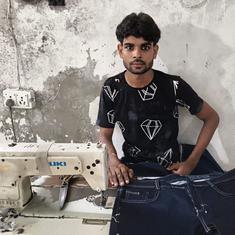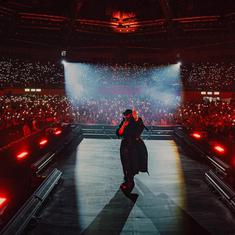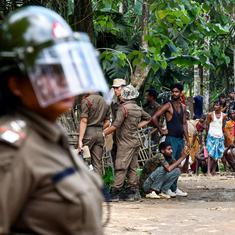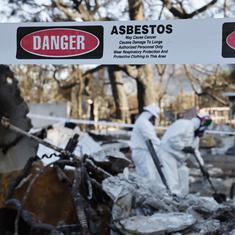In the early hours of 16 May, the Everest climbing team departed from Camp 2, heading towards the bergschrund at the base of the Lhotse wall. We made good progress, with Sauraj leading us efficiently up the gruelling, 70° incline of the ice wall. Along the way, we encountered climbers being escorted down on oxygen and ropes, assisted by a dedicated rescue team. We were aware that Seven Summit Treks had stationed a ten-person rescue team at Camp 2 this season. Their careful, methodical work left us impressed by their commitment and efficiency.
As we neared Camp 3 (7,450 m), we crossed paths with the Lhotse team who were descending from the mountain. They looked utterly spent, having endured fierce winds and the relentless strain of extreme altitude. We offered our heartfelt congratulations, then approached Mingma with a mix of apprehension and hope. To our immense relief, his demeanour was free of bitterness or resentment. He reassured us that he would indeed be our expedition leader. Despite descending with his team, he promised to return early the next morning and ascend to South Col with us. Buoyed by his reassuring words, we reached Camp 3 and spent another restless night in our tent, precariously perched on the steep incline of the Lhotse wall.
The morning of 17 May dawned quietly, without much ordeal. Despite the biting cold, the awkward angle of the tent and the extreme altitude, I had slept relatively well, wrapped in my down suit and breathing from an oxygen tank. After lacing up my boots, packing my sleeping bag and strapping on my climbing harness, I stepped out of the tent to allow Sauraj to get ready in the cramped space. That day’s ascent to South Col required us to use supplementary oxygen to survive in the thinning atmosphere. We were about to enter the “Death Zone”.
Outside, chaos reigned. Teams scrambled around their tents, and climbers jostled to get onto the main fixed line running through Camp 3 which led up the mountain. The sub-zero temperatures turned every task into an agonising struggle. Replacing oxygen cylinders, managing regulators, adjusting crampons and packing up the tents became Herculean efforts, each task taking twice as long as usual. By the time we were set to start at 6:30 am, my hands were painfully frozen despite wearing gloves. My only thought was, ‘Let’s move.’
Spotting Pemba clipping onto the main fixed line, I followed, hoping the act of climbing would relieve the burning cold in my extremities. We began the slow ascent up the ropes, confident that the rest of our team would be just minutes behind. As we reached the first crest, about twenty minutes out of Camp 3, I noticed a climber ahead, sitting in the snow with his down suit half unzipped and his hands bare despite the extremely cold temperatures, which was a shocking sight. Pemba and I reached him to find him dazed and struggling with his oxygen mask. A Sherpa climber was attempting to assist him, but he seemed disoriented. I voiced my concern to Pemba, who quickly communicated with the Sherpa and then turned to me, translating: “Russian climber going down. Needs rescue!” Pemba immediately radioed Camp 2, and we received confirmation that the rescue team was aware of the situation and on its way.
As Lakpa Tenzi led Sauraj, Vikas and Takeshi up to us, I saw the shock and alarm etched on their faces as they took in the sight of the incapacitated climber. “Oh God! Are you okay? Is he okay?” Vikas shouted through his face mask. “Let’s help him,” said Sauraj, taking a few steps towards the climber. But Lakpa and Pemba quickly stopped him, emphasising that the rescue team was already on its way. Though we were eager to assist, Pemba insisted we keep moving. The rescue team would arrive any moment, and we were ill-equipped to handle a medical emergency of this scale.
Visibly shaken, we resumed our ascent. The encounter had left an indelible mark on our minds, starkly illustrating the perilous nature of high-altitude mountaineering. As we climbed the Lhotse Face, each step felt like a heavy, painful reminder of the danger we faced. My thoughts drifted into a dark chasm of anxiety and fear, overshadowing the once glorious summit aspirations. The focus of my solemn prayers shifted from “Dear God, please let me succeed” to “Please, just let me survive”.
We must have been climbing for another sixty minutes when we heard Mingma Tenzi Sherpa’s deep, commanding voice behind us. He had started his ascent all the way from Camp 2 early that morning after a good night’s sleep. Having joined the rescue team, he had caught up with us, bringing with him the reassuring news that the Russian climber was being evacuated. With Mingma’s presence and the rising sun, our earlier fears began to dissolve, and our spirits were renewed. Mingma directed the Sherpa team to advance at their faster pace, while the four of us followed him up the Lhotse wall.
I stayed close behind Mingma, constantly in awe of his strength and resilience. Here was a man who had just led an expedition up Lhotse, the fourth-highest mountain in the world. After descending the previous day and getting only one night’s rest, he was back on the mountain, leading us up the Lhotse wall as if it were a morning stroll. Acclimatised to the high altitude, he wasn’t even wearing an oxygen mask. Watching him effortlessly stride ahead, occasionally looking back with a reassuring smile, filled me with immense gratitude and admiration. His superhuman strength and unwavering calm were a beacon of hope amidst the daunting climb.
It took us nearly six hours to ascend the Lhotse wall. With a final, strenuous push, I hauled myself over the rock ledge marking the top of the Geneva Spur and secured myself at the anchor point before sinking into a well-earned rest. It was just 12.30 pm, and we had already conquered the most challenging section of the day. Our tents at South Col were now only a short 20-minute walk away. As I took in the breathtaking panorama of the Western Cwm below, I marvelled at the fact that we were back here at 8,000 m above the world. Despite the uncertainties of the next 24 hours, we had defied the odds and reached this pivotal point where only a brave few had ventured.
Sauraj climbed up to the Geneva Spur, his eyes locked on the Everest summit, where a fierce white plume of snow trailed from its dark, jagged edge. His face was a mask of intense focus and unyielding determination, capturing the summit that had eluded us for four long years. When he turned towards me, I captured the moment on camera: Sauraj, resolute and powerful, with Everest’s pinnacle daring us to test our resolve against its towering heights. We took a breath to appreciate the significance of our achievement before Takeshi and Vikas arrived. Once they had caught their breath, we pushed onward together, tackling the final few hundred metres to our camp. As we emerged from the shadow of Lhotse and entered the exposed basin of South Col, a powerful gust of wind hit us. I looked up at the peak, dismayed to see that the snow plume was a stark reminder of the fierce winds at the summit. Despite the forecast of clear weather, we were once again battered by icy winds at Camp 4.
The support team of Sherpas was impeccably organised. Arriving an hour earlier, they had already pitched most of the tents and started heating water. We, utterly spent from the gruelling climb up the Lhotse wall, bundled into a single tent with immense relief. The tent, shielded from the relentless wind, surprisingly offered warmth, which began to aid our recovery. Inside, we adjusted our climbing gear and found solace in the confined space, which now felt like a sanctuary. Mingma came by with a flask of hot water, checking on each of us and ensuring we were okay. He took a quick inventory of our oxygen regulators and advised us to change into dry clothes. He even insisted we remove the insoles from our boots to prevent frostbite – a crucial piece of advice that later proved invaluable. One of the Sherpas, who had neglected to do this, later suffered severe frostbite and had to be evacuated.
As we huddled in our tent, preparing for the long, arduous night ahead, we drew immense comfort from each other’s presence. After enduring the harsh conditions of the past two months together, our shared experiences had forged a bond of strength. Words of caution and advice were received with grace, and even moments of silence were filled with a profound sense of camaraderie. Vikas’s calm demeanour, Takeshi’s inadvertent humour and Sauraj’s unwavering determination each contributed to a renewed sense of confidence. Despite our diverse personalities, we drew strength from one another.
Outside, the winds raged on, tearing at anything not securely anchored. Memories from a year ago haunted us, but we kept them at bay. The tent, packed tightly with the four of us in our down suits and sleeping bags, became our fortress. With easy access to oxygen, hot tea for hydration and a generous supply of chips, chocolates and dried fruits fuelling us, our bodies began to recover and our spirits lifted. Sauraj had even managed to bring a pack of Uno, resulting in perhaps the highest game of Uno in the world.
With the unwavering support of our Sherpa team and Mingma’s vigilant care, we managed to recover well during the seven hours we spent at South Col. As the sun dipped below the horizon, the ferocious winds began to ease. The weather forecast had proven accurate, offering a brief respite from the relentless elements. With our departure set for 8 pm, we made the most of the final hours, retreating into our sleeping bags and mentally bracing ourselves for the gruelling night ahead.
Everything above us was uncharted territory, an alien expanse of ice and rock. We had no inkling of the trials that lay in wait, only the daunting knowledge that the coming hours would test our limits in ways we could scarcely imagine. The anticipation was palpable, mingling with the cold, as we settled in, preparing for the unknown challenges that awaited us in the darkness.

Excerpted with permission from What's Your Everest?: A Path to Passion and Purpose, Samir Patham and Sauraj Jhingan, Bloomsbury India.










